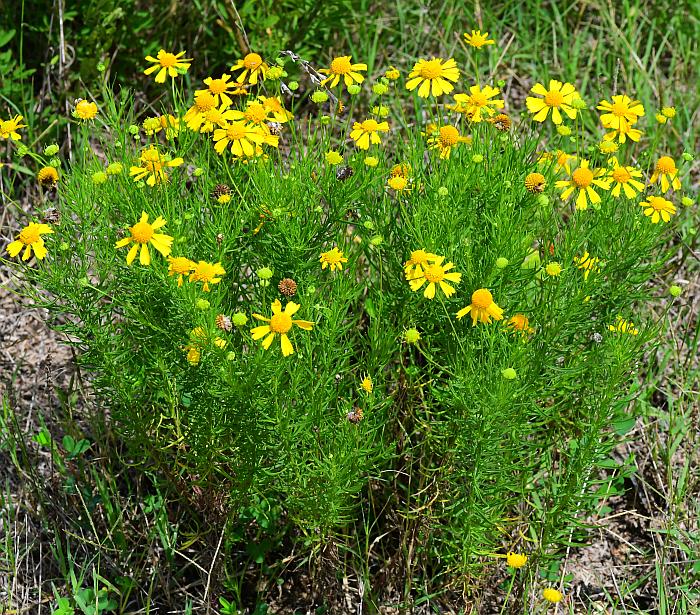Helenium amarum (Raf.) H. Rock
Bitterweed

Introduced
CC = *
CW = 3
MOC = 52
© SRTurner
Helenium amarum (Raf.) H. RockBitterweed | |
 |
Introduced CC = * CW = 3 MOC = 52 |
© SRTurner |
|
Family - Asteraceae/Heliantheae Habit - Taprooted annual forb. Stem - Ascending to erect, to 40 cm or more, usually branched, finely ridged, not winged, glabrous or sparsely pubescent with short, antrorse hairs, also moderately to densely dotted with sessile to impressed, yellow glands.
Leaves - Deeply pinnately divided, glabrous but densely dotted with sessile to impressed, yellow glands. Basal and lowermost stem leaves absent or withered at flowering, somewhat smaller than the median stem leaves, the blade outline linear or rarely ovate and then deeply pinnately divided into narrowly linear segments. Median and upper stem leaves 1-8 cm long, linear to narrowly linear, unlobed, the margins entire, tapered at the base, not decurrent along the stem, tapered to a sharply pointed tip.
Inflorescences - Solitary heads terminal branch tips, the heads appearing mostly long-stalked.
Heads - Radiate. Involucre 5-9 mm long, 6-12 mm in diameter, saucer-shaped. Involucral bracts 15-21, in 2 unequal to subequal series, usually with a bluntly thickened, sometimes pinkish- or purplish-tinged midnerve, glabrous or the outer surface sparsely pubescent with minute, ascending hairs, both surfaces also densely gland-dotted. Receptacle strongly convex, hemispherical to nearly globose, often slightly enlarging as the fruits mature, naked.
Florets - Ray florets 5-10 in usually 1 series, pistillate, the corolla 5-12 mm long, relatively broad above a slender base, yellow, the tubular portion and the undersurface of the ligule with sparse to moderate, minute, curled hairs and also with moderate to dense, sessile and spherical or somewhat impressed, yellow glands. Disc florets numerous, perfect, the corolla 1.5-3.0 mm long, yellow, glandular, the 5 sharply pointed lobes also glandular on the outer surface. Style branches with the sterile tip slightly expanded and more or less truncate. Pappus of 6-8 scales, 1.0-1.8 mm long, these papery and white or thinner and nearly transparent, lanceolate to narrowly ovate, tapered to a relatively long-awned tip, the margins usually slightly irregular.
Fruits - Achenes 0.7-1.5 mm long, wedge-shaped, with 4 or 5 angles or slender ribs, the surface brown, relatively densely pubescent with ascending, yellowish hairs.
Flowering - June - November. Habitat - Roadsides, pastures, forest openings, prairies, railroads, open disturbed areas. Origin - Native to the southern U.S. Lookalikes - Broadly, other species in the Helenium genus. Other info. - This distinctive species is found in Missouri mostly south of the Missouri River. It is relatively uncommon near the center latitude of the state, becoming much more common toward the southern border. In regions near the Bootheel it is a very common roadside weed. In the U.S. its distribution is mostly southern and southeastern. Though considered introduced in Missouri, it is apparently native in nearby Oklahoma and farther south, in Texas and Louisiana. Photographs taken at Crowley's Ridge Conservation Area, Stoddard County, MO, 8-14-2009, in Pilot Knob, Iron County, MO, 7-29-2013, at Holly Ridge Conservation Area, Stoddard County, MO, 8-13-2015 and 8-15-2021, and along the Glade Top Trail, Ozark County, MO, 9-23-2017 (SRTurner). |